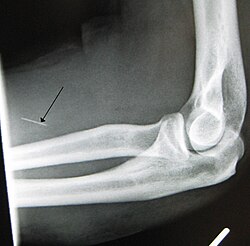
Back Nitrožilní aplikace Czech Intravenøs administration Danish Intravenös German تزریق دارو Persian Intravenoosi Finnish Injection intraveineuse French Intraveneus Dutch Intravenøs behandling NN Intravenøs infusjon NB Zastrzyk dożylny Polish
This article possibly contains original research. (April 2019) |

Drug injection is a method of introducing a drug into the bloodstream via a hollow hypodermic needle, which is pierced through the skin into the body (usually intravenously, but also at an intramuscular or subcutaneous, location). Intravenous therapy, a form of drug injection, is universally practiced in modernized medical care. As of 2004[update], there were 13.2 million people worldwide who self-administered injection drugs outside of medical supervision,[clarification needed] of which 22% are from developed countries.[1]
A wide variety of drugs are injected, often opioids: these may include legally prescribed medicines and medication such as morphine, as well as stronger compounds often favored in recreational drug use, which are often illegal. Although there are various methods of taking drugs, injection is favoured by some people as the full effects of the drug are experienced very quickly, typically in five to ten seconds. It also bypasses first-pass metabolism in the liver, resulting in higher bioavailability and efficiency for many drugs (such as morphine or diacetylmorphine/heroin; roughly two-thirds of which is destroyed in the liver when consumed orally) than oral ingestion would. The effect is that the person gets a stronger (yet shorter-acting) effect from the same amount of the drug. Drug injection is therefore often related to substance dependence.
In recreational-use drug culture, preparation may include mixing the powdered drug with water to create an aqueous solution, and then the solution is injected. This act is often colloquially referred to as "slamming", "shooting up", "smashing", "banging", "pinning", or "jacking-up", often depending on the specific drug subculture in which the term is used (e.g. heroin, cocaine, or methamphetamine).
- ^ Academies, Committee on the Prevention of HIV Infection Among Injecting Drug Users in High-Risk Countries, Board on Global Health, Institute of Medicine of the National (2007). Preventing HIV infection among injecting drug users in high-risk countries an assessment of the evidence. Washington, D.C.: National Academies Press. ISBN 978-0-309-10280-3.
{{cite book}}: CS1 maint: multiple names: authors list (link)
© MMXXIII Rich X Search. We shall prevail. All rights reserved. Rich X Search